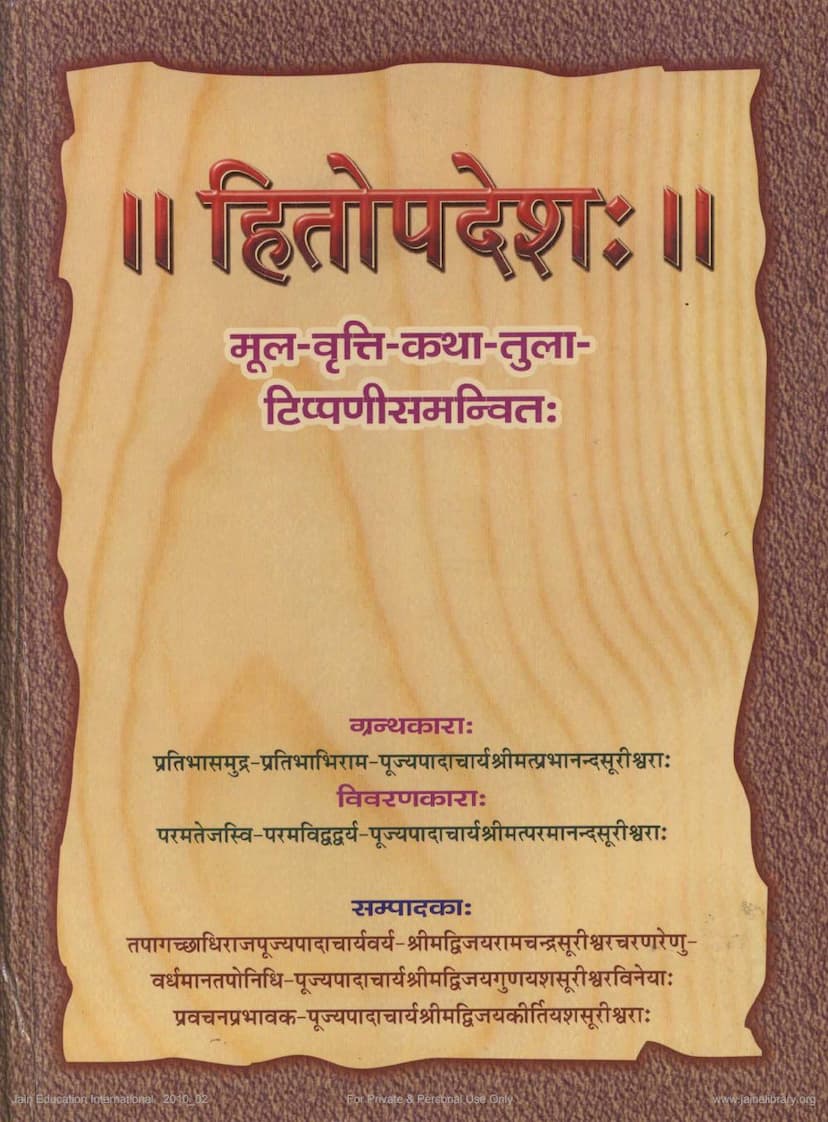Hitopadesh
Added to library: September 1, 2025

Summary
The Jain text "Hitopadesh" (हितोपदेशः), authored by Prabhanandsuri, Parmanandsuri, and Kirtiyashsuri and published by Sanmarg Prakashan, is a comprehensive treatise on the path of spiritual liberation as expounded in Jain philosophy. This work, also known as "Hitopadesh-mula-vritti-katha-tulatippani-samanvitah" (हितोपदेशः मूल-वृत्ति-कथा-तुला-टिप्पणी-समन्वितः), delves into the essential principles for spiritual advancement, categorized into distinct chapters or "dwars" (द्वार).
The book is structured around four main sections:
- Sumvishuddha Samyakttva (सुविशुद्धं सम्यक्त्वं): This initial section focuses on the foundational principles of Right Faith (Samyakttva), emphasizing its purity and the discernment between right and wrong beliefs. It details the thirteen virtues necessary for attaining Samyaktva, its five doshas (faults), five lakshanas (characteristics), and five bhushanas (ornaments). The importance of cultivating virtues like Dana (charity), Shila (virtuous conduct), and Tapas (asceticism) is highlighted. The text also explains the significance of Bhava Dharma (inner devotion) and the detrimental nature of attachment to worldly pleasures.
- Uttamaguna Sangraha (उत्तमगुणसङ्ग्रहः): This section elaborates on the ten virtues that are crucial for spiritual progress: Daan (charity), Sheel (virtuous conduct), Tapa (asceticism), Bhava (inner disposition), Vinay (humility), Paropakara (benevolence), Uchitaacharana (proper conduct), Desha-rajya-loka-dharma Viruddha Tyaga (renunciation of country, state, people, and religion-opposed actions), Atmotkarsha Tyaga (renunciation of self-exaltation), and Krutadnyata (gratitude). The text emphasizes the role of these virtues in stabilizing Right Faith and leading to ultimate liberation.
- Daan (Charity): Elaborated into four types: Abhaya Daan (fearlessness), Anukampa Daan (compassion), Gyaan Daan (knowledge), and Bhakti Daan (devotion).
- Sheel (Virtuous Conduct): Described as difficult but essential for overcoming desires.
- Tapa (Asceticism): Explained in twelve types, both external and internal, highlighting its power to destroy even karmic bonds accumulated over countless lives.
- Bhava (Inner Disposition): Emphasized as the core of righteous actions; without it, charity, conduct, and asceticism become mere external rituals.
- Vinay (Humility): Discussed in its worldly and spiritual forms, stressing its importance in spiritual growth and overcoming ego.
- Paropakara (Benevolence): Described in terms of material and spiritual help, highlighting the duty of humans, endowed with consciousness, to benefit others.
- Uchitacharana (Proper Conduct): Detailed with respect to behavior towards parents, siblings, spouse, children, relatives, spiritual teachers, society, and even other religious sects.
- Desha-rajya-loka-dharma Viruddha Tyaga (Renunciation of actions against country, state, people, and religion): Explaining the negative consequences of acting against these principles and advocating for their avoidance.
- Atmotkarsha Tyaga (Renunciation of self-exaltation): Warning against pride and self-praise, which nullify spiritual practices.
- Krutadnyata (Gratitude): Praising gratitude and condemning ingratitude, emphasizing its role in spiritual development.
- Abhinivesha Tyaga (Renunciation of stubbornness): Cautioning against rigid adherence to personal beliefs, which can hinder spiritual progress and lead to wrong paths.
- Virati Dwara (विरतिद्वार): This section covers the principles of restraint, divided into Desa Virati (partial restraint) and Sarva Virati (complete restraint). It outlines the twelve vows of lay followers and the five Mahavratas (great vows) for ascetics, along with their associated cautionary practices (Aticharas). The text details the essential role of virtue in overcoming passions, particularly anger, ego, deceit, and greed.
- Grahaadi Viruddha Tyaga (देशादिविरुद्धपरिहार): This final section emphasizes the importance of renouncing actions that are against the norms of the country, time, ruler, society, and Dharma. It highlights the interconnectedness of these aspects and advises adherence to righteous conduct in all circumstances.
The text also includes biographical information about the authors and editors, particularly highlighting the lineage and spiritual contributions of Acharya Shrimat Prabhanandsuri and Acharya Shrimat Parmanandsuri. It mentions the historical context of the work, noting its commentary, compilation, and publication, and underscores the scholarly efforts involved in its presentation. The publication is also noted as being supported by various Jain trusts and institutions, reflecting its significance within the Jain community. The book further includes a detailed index (Kramdarshan - क्रमदर्शनम्) which categorizes the content by topic and verse numbers, aiding readers in navigating the extensive text. Throughout the work, the authors weave in ethical teachings and narratives from Jain tradition, such as the story of Mrigaputra and the importance of righteous living, to illustrate their points. The overall aim of "Hitopadesh" is to guide individuals towards spiritual well-being and ultimate liberation through the practice of virtues and adherence to Jain principles.